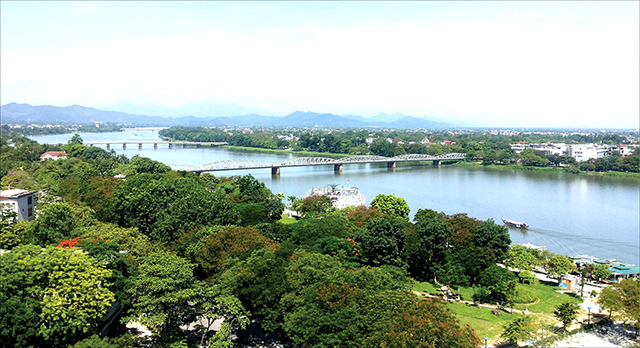
Hue needs to grow, to change, but to remain a "masterpiece of urban poetry”. Photo: Phan Thanh
There are people who agree with the above idea, but disagree with the article's argument: "Hue will not develop without the quiet and slowness; otherwise, Hue would no longer be Hue." This idea raises a question of what to keep and what to develop, how slow and how fast ... So we want to continue discussing the slow and fast story of Hue. It is a long story about the constructional innovation of Hue city, and also a pressing matter in the business development of Hue.
Fifteen years ago, a Hanoi architect visiting Hue wondered: "If Hue is built into a vibrant, busy city – then it would no longer be Hue. Yet in keeping its calm and quiet - Hue will not be able to develop.” That was the statement of architect Hoang Minh Thai (Hanoi University of Architecture) at the Setting up an exclusive architectural appearance for Hue workshop held by the Vietnam Architects Association in March 2002.
Also at the conference, most of the leading experts in Vietnamese architecture have identified "romantic" as a feature of Hue. The architects recalled a good summary of a Russian architect, Mr. Mudrin: "There are many cities in the world: worker cities, scientific cities, port cities, giant and supergiant cities. But a poetic city is rare. Yet in Vietnam there exists a city like that. That is Hue." The then Director General of UNESCO - Mr. Amadou Mahtar M'Bow – proclaimed a conclusion that becomes a point of reference: "Hue – a masterpiece of urban poetry."
Just like every other city in Vietnam, Hue needs to grow, expand, renovate, and build new things. However, how to make the city more spacious and modern but still remain an "urban poem" marvel? Architect Nguyen Truc Lanh - previous President of the Vietnam Association of Architects - gave the answer that was how to balance the relationship between nature - people - architecture in proportion. He noted the deep and quiet manner, the mutual respect for each other in the behavior of the Hue citizens, and warned: "If we ever lose it, if we blindly follow the high house and the wide road, the facade-focused architectural styles that seem to have sprung up on the streets of Hue, Hue will no longer be Hue."
In general, urban design experts have determined on the appearance of Hue as a city of romance, with a relaxed style of residents, in quiet space without vehicle horn or smog. It is a unique value exclusive to Hue. That value is especially rare amidst the stage of the increasingly degraded natural and social environment by the industrial chimneys and the fast-paced lifestyle of consumerism and pragmatic enjoyment. Recently, we have heard people talking about the concept of Slow City - a slow-pace city. Can that city be Hue? Many visitors coming from crowded urban areas like Ho Chi Minh city, Hanoi said they actually like the slow pace of Hue. “Live slowly with Hue” is such a great idea to create attractive products for Hue tourism.
"It’s hard to find a city like Hue, where you can hear the sound of the leaves softly swaying, and the breathing of the grass late at night," writer Ho Dang Thanh Ngoc wrote about the quietness of Hue. Of course, saying that Hue is quiet does not mean Hue does not accept the liveliness; saying the people of Hue live slowly does not mean they are not fast either.
Anyone who has a chance to come to Hue Festival can see a passionate, exciting side of Hue. Hue is open throughout the day to exhibit, display, and stay up all night singing and dancing with artists and travelers from wherever. Festivals must be filled with sounds and colorful lights, and Hue has never rejected them. Even when Hue was bustling with the Festival, some people have claimed that Hue was no longer Hue. Yet, I do not think that Hue lost its tranquility and leisureliness to the excitement of the festival, as it is just temporary, in some places, in a few days. As soon as the festival comes to an end, Hue returns to its usual tranquility.
The people of Hue are slow, but not that they are incapable of adapting to changes or new things. It’s just that they are active and vibrant in their own way, gently and leisurely.
Visitors are impressed with the joke that in Hue the response to any inquiry about waiting is always "Could you please wait for a second?" That response implies the leisureliness in Hue personality and the inherent slowness of Hue. Likewise, the other side of reserve is the lack of openness; the negative side of considerateness is discomfort; nostalgia accompanies conservative manner; relaxation can easily lead to inaction; tranquility and serenity can be a barrier to development...
After all, the existence of such pairs of opposite is a matter of course. Therefore, the work of the leader and the social manager is to know how to handle the two opposite sides of a category wisely, so that Hue can develop without losing itself. Hue must be modern and fresh, but still remain ancient and romantic.
By Minh Tu